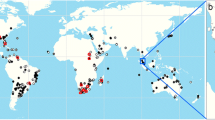Abstract
The geographic range of the black howler,Alouatta pigra in Mexico, Guatemala, and Belize was investigated by travelling through and visiting 65 locations within or close to the expected range. The existence of the species was noted through first hand observations or was documented by talking with residents and knowledgeable people in the area. Observations were made on captive animals as well. All sites and probable sites ofA. pigra were noted to be under 1,300 ft in altitude and in areas with a mean annual temperature above 25°C and a mean annual rainfall over 1,000 mm per year. This area coincides with tropical rain forest areas, including both tropical evergreen and semievergreen rain forests.A. pigra was most plentiful in riverine areas which showed flooding for some part of the year. Two areas of possible sympatry withA. palliata were noted. In all cases, the troop sizes ofA. pigra were extremely small, under ten individuals, and infants could easily be sexed, in contrast toA. palliata which is known to occur in troops of 15–18 and is difficult to sex at an early age. Finally, a very gross method for population estimation from searching time emerged from the study.
Similar content being viewed by others
References
Atlas of Central America, 1979. Univ. of Texas, Austin.
Atlas Climatologico de Guatemala, 1964.Observatorio Nacional IAN. Ministerio de Agricultura.
Atlas of Mexico, 1975. Univ. of Texas, Austin.
Baldwin, J. D. &J. I. Baldwin, 1972. Population density and use of space in howling monkeys (Alouatta villosa) in southwestern Panama.Primates, 13: 371–379.
Bolin, I., 1981. Male parental behavior in black howler monkeys (Alouatta palliata pigra) in Belize and Guatemala.Primates, 22: 349–360.
Braza, F., F. Alvarez, &T. Azcarate, 1981. Behaviour of the red howler monkey (Alouatta seniculus) in the Llanos of Venezuela.Primates, 22: 459–473.
Carpenter, C. G., 1934. A field study of the behavior and social relations of howling monkeys (Alouatta palliata).Comp. Psych. Monogr., 10: 1–168.
————, 1962. Field studies of a primate population. In:Roots of Behavior,E. L. Bliss (ed.), Harper Brothers, New York, pp. 286–294.
Chivers, D. J., 1969. On the daily behaviour and spacing of howling monkey groups.Folia Primatol., 10: 48–102.
Clarke, M. R. &K. E. Glander, 1983. Variability in reproductive success of free-ranging female mantled howlers over an 11-year period.Amer. J. Primatol., 4: 340.
Coelho, A. M., L. S. Coelho, C. A. Bramblett, S. S. Bramblett, &L. B. Quick, 1976. Ecology, population characteristics, and sympatric association in primates: a socio-bioenergetic analysis of howler and spider monkeys in Tikal, Guatemala.Yb. Phys. Anthropol., 20: 96–135.
Cordeiro da Silva, E., 1981. A preliminary survey of brown howler monkeys (Alouatta fusca) at the Cantareira reserve (SĂo Paulo, Brazil).Rev. Brasil. Biol., 41: 897–909.
Estrada, A., 1982. Survey and census of howler monkeys (Alouatta palliata) in the rain forest of “Los Tuxtlas,” Vera Cruz, Mexico.Amer. J. Primatol., 2: 363–372.
————, 1983. Primate studies at the biological reserve “Los Tuxtlas,” Vera Cruz, Mexico.IUCN/SSC Primate Specialist Group Newslet., 3: 21.
Furley, P. A. &A. J. Crosbie, 1974.Geography of Belize. Collins, London.
Garciá, E., 1973. Modificationes al Sistema de Clasificacion Climatica al Koppën. UNAM Instituto de Geografía, Mexico.
Glander, K. E., 1980. Reproduction and population growth in free-ranging mantled howling monkeys.Amer. J. Anthropol., 53: 25–36.
Horwich, R. H., 1983. Species status of the black howler monkey,Alouatta pigra, of Belize.Primates, 24: 288–289.
———— &K. Gebhard, 1983. Roaring rhythms in black howler monkeys (Alouatta pigra) of Belize.Primates, 24: 290–296.
IUCN, 1978.The Red Data Book, Vol. 1, Mammalia. IUCN, Morges,
Mittermeier, R. A., 1973. Group activity and population dynamics of the howler monkey on Barro Colorado Island.Primates, 14: 1–19.
Neville, M. K., 1972. The population structure of red howler monkeys (Alouatta seniculus) in Trinidad and Venezuela.Folia Primatol., 17: 56–85.
Pennington, T. D. &J. Sarukhan, 1968.Arboles Tropicales de Mexico. Instituto Nacional de Investigaciones Forestales, Mexico.
Rudran, R., 1979. The demography and social mobility of a red howler (Alouatta seniculus) population in Venezuela. In:Vertebrate Ecology in the Northern Neotropics,J. F. Eisenberg (ed.), Smithsonian Institution Press, Washington, D.C., pp. 107–126.
Rzedowski, J., 1978.Vegetacion de Mexico. Editorial Limusa, Mexico.
Smith, J. D., 1970. The systematic status of the black howler monkey,Alouatta pigra Lawrence.J. Mammal., 51: 358–369.
Toledo, V. M., 1982. Pleistocene changes of vegetation in tropical Mexico. In:Biological Diversification in the Tropics,G. T. Prances (ed.), Columbia Univ. Press, New York, pp. 93–111.
Author information
Authors and Affiliations
About this article
Cite this article
Horwich, R.H., Johnson, E.D. Geographical distribution of the black howler (Alouatta pigra) in Central America. Primates 27, 53–62 (1986). https://doi.org/10.1007/BF02382522
Received:
Accepted:
Issue Date:
DOI: https://doi.org/10.1007/BF02382522




